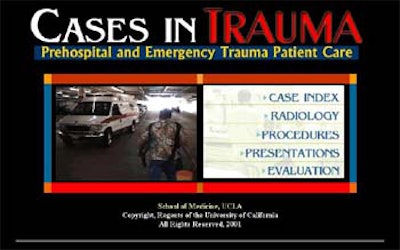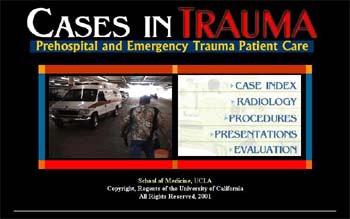
Seizing the opportunity to teach to a worldwide classroom, two different online, interactive emergency radiology primers have been developed for use by residents, medical students, and even attending physicians who are looking for a quick review session.
Thea Trotscher, along with Dr. John Harris, Jr., professor emeritus at the University of Texas at Houston, unveiled the Web-based primer at the 2001 American Society of Emergency Radiology conference in San Francisco. Trotscher is a nurse specializing in radiology and research at the medical college.
The primer focuses on policy and protocols for various procedures in a trauma setting, such as head and neck imaging and spinal imaging. Each chapter contains indications and contraindications for different modalities, imaging sequences, and key anatomic and pathologic terms, which are linked to explanatory images.
"What we wanted to do was have the image without hot spots on it or anything to get in the way of the anatomy," Trotscher explained. "We did want [users] to be able to test themselves. Once they’ve done that, they can roll the mouse over the image so that the image legend then pops up."
Currently available chapters cover the skull, face and mandible, and spine. Sections covering the skeletal system, abdomen, and other areas are in the works.
 |
Meanwhile, the creators of Cases in Trauma: Prehospital and Emergency Trauma Patient Care, are gearing up to launch their site in 2001. Dr. Ira Scott Smalberg from the school of medicine at the University of California, Los Angeles highlighted key aspects of the site at the ASER meeting.
"One of the challenges of teaching students the principles of emergency trauma patient care is that between a short rotation and a rigorous curriculum, there is little time to devote to such an important subject," said Smalberg, an assistant professor in the department of radiological sciences.
The multidisciplinary Web site will use footage of digitally videotaped major code-trauma patients, from the time they arrive at the medical center to the initial resuscitation effort. Each patient video will be combined with patient radiology and didactic teaching materials.
Smalberg and his co-creators, Dr. Eric Savitsky and Anju Relan, Ph.D, used cutting-edge technologies to achieve a "high-fidelity, immersive learning experience." Along with the digital video, the site will feature synchronized slides and QuickTime virtual reality presentations.
Audiovisual clips will be paired with a series of multiple-choice questions. Repeat visits to the cases are possible because each answer will either lead the user to a different section, or offer the option of continuing with the case.
"The idea is that when someone answers a question incorrectly, he or she will then get information as to why that is not the correct answer, with additional links to extra detailed information about that answer," Smalberg wrote in an e-mail to AuntMinnie.com.
Users are also invited to fill out an evaluation form. Their responses, as well as their interactions with the site, will be captured in a database that will be used to design future site changes and improvements, he said.
Smalberg said he expects the site to go live by July 1, 2001.
By Shalmali PalAuntMinnie.com staff writer
April 27, 2001
Click here to post your comments about this story in our Residents Digital Community. Please include the headline of the article in your message.
Copyright © 2001 AuntMinnie.com



















